Challah done two ways from the same dough (Jewish New Year’s loaf AND a braided challah)
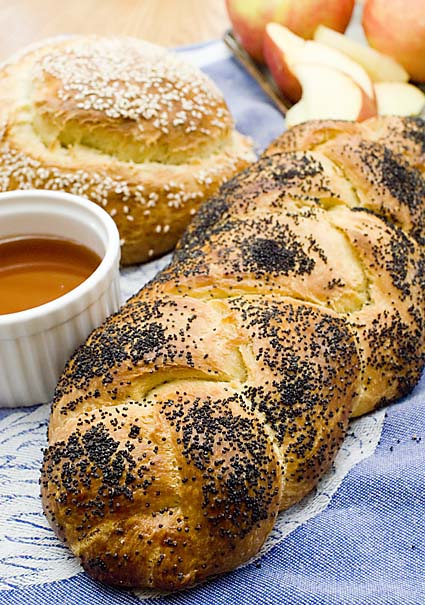
It’s Jewish New Year (tonight) and the traditional loaf, a round, turban-shaped one (round=continuity of life) took a back seat in this photo– so I decided to do a challah extravaganza and go through both shapes, which are easy once you see how they’re done. Here’s the turban from a little closer:
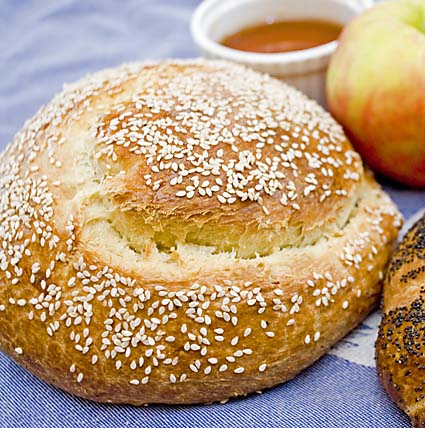
They’re both made from the same dough but the New Year’s turban always has raisins or other sweet fruit (to symbolize a sweet new year)– we’ll roll them into the dough so you don’t have to mix up a special one. First, roll out some pre-mixed challah dough from page 296 of the book (purchase by clicking here). You can even make it with brioche dough if you’re looking for something richer, but the less rich dough is more traditional. Roll a grapefruit-sized piece of dough as in Zoe’s post on raisin bread, sprinkle a handful of raisins, roll it back up, and and you’ll get something that looks like this:

Thin out one end by rolling and stretching at the end that’s going to be thinned:
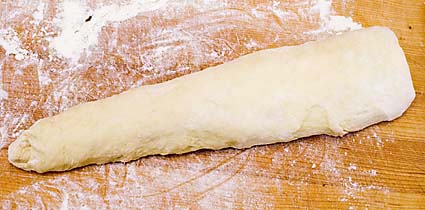
Starting with thick end in the middle, wind the thinner end around it and finally, tuck it underneath to seal:
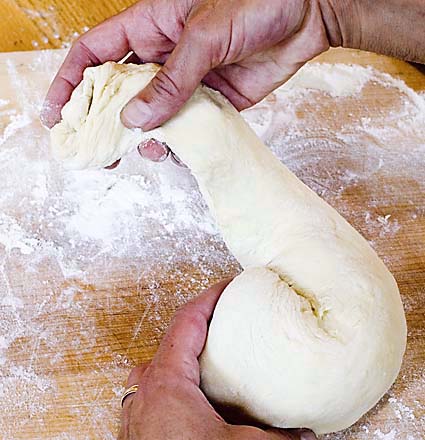
Put the loaf on a cookie sheet prepared with shortening or parchment paper, or my favorite these days, a silicone pad, which can go straight into the oven with or without the support of a cookie sheet. Brush the loaf with egg wash and sprinkle with sesame seeds:
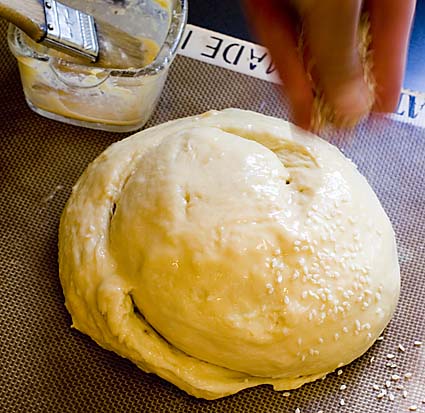
Allow the loaf to rest for an hour and 20 minutes, then bake at 350 degrees F (175 degrees C) for about 30 minutes, until nicely browned (larger loaves will take more time). Here’s the finished turban-shaped loaf again, ready for eating with apples and honey for a sweet new year:

But if you want to make the traditional braided challah (without raisins), here’s how to do it: First form a grapefruit-sized ball and cut it into thirds with a knife or dough scraper.
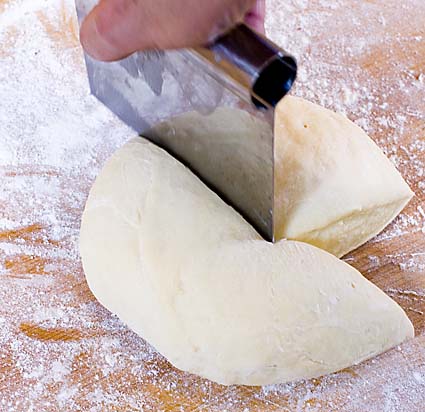
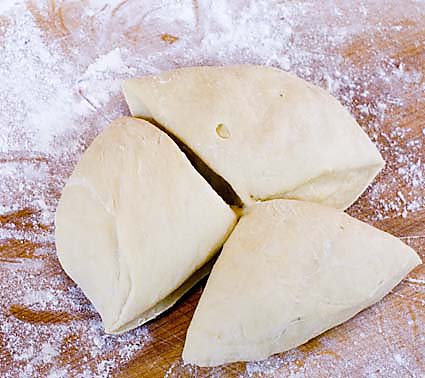
Gently roll and stretch each piece, dusting with flour so your hands don’t stick to it, until it’s about an inch thick. You may need to walk away and let the dough relax for five minutes so it won’t resist your efforts. When you’re done, lay them straight on a lightly floured work surface:

The key to a beatiful braid is to start from the middle, not from one of the ends. Pull the strand farthest from you over the middle strand and lay it in the middle– that’s never changes, you’re always pulling outside strands into the middle, and you never move the middle strand:
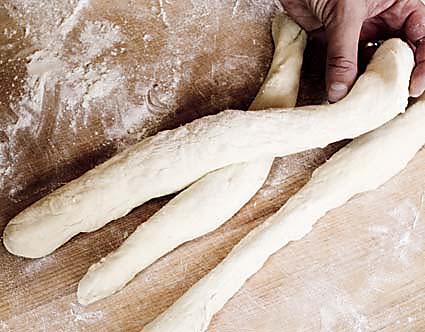
Now pull the closer strand over to the middle:
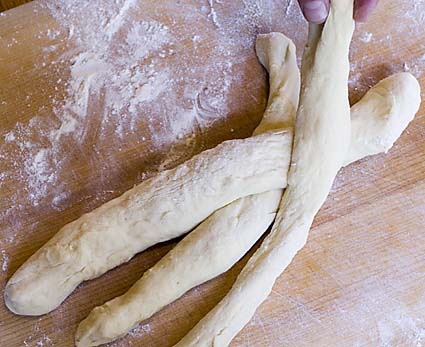
Keep going, alternating outer strands but always pulling it into the middle:
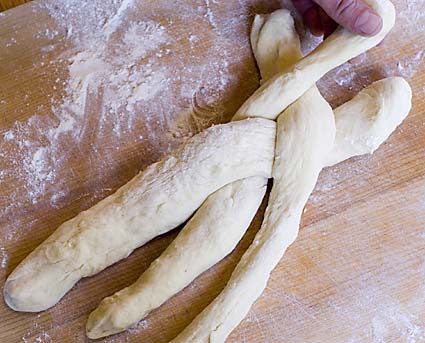
When you get to the end, pinch the strands together:

Now (and this is the fun part), flip it over so the loose strands fan away from you:

Start braiding again by pulling an outside strand to the middle, but this time start with the strand closer to you:

Don’t worry if things look a little mis-shapen, you can nudge it back into shape at the end. Braid to the end again, and pinch together, lay it on a cookie sheet prepared with shortening, parchment, or a silicone pad, and paint it with egg wash:

Using my fingers, I’ve gently nudged the loaf into a more symmetrical shape before painting the egg wash:
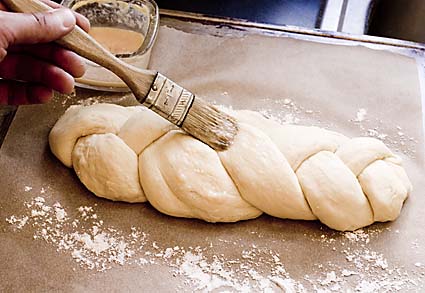
Now sprinkle with poppy seeds:
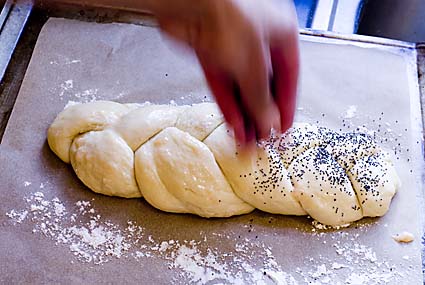
Allow the loaf to rest for an hour and 20 minutes, then bake for about 30 minutes at 350 degrees F (175 degrees C), and the colors create a beautiful contrast:

Follow us on Twitter.com!
Hello Jeff & Zoe,
Apple & Honey Whole Grain Challah in the new book – hand mixed, Bob’s Red Mill flour, fresh eggs, organic Braeburns. The apples absorbed a bitter flavor from something. Perhaps bitter in the fermented yeasty sense someone refers to above. Any thoughts on what might have caused it, and how to avoid a similar reaction in the future?
Thanks, Becca
Becca: I have not experienced that. I’m guessing it will be less pronounced if you use all the dough within 2 days or so… bet this got worse with time. If it’s the yeast, try a low-yeast version, see https://artisanbreadinfive.com/?p=85 Jeff
I’ve made the challah a few times. I cut the yeast in half and let it rise for 2 hours. Then it sits in the fridge for a day or two. I’m using KA flour and measuring by weight. I have 2 issues. The dough seems very wet. It even kind of sticks to a silpat. Is this from reducing the yeast? Or do I just need more flour or less water? The same thing has happened several times, so I don’t think that it’s a mismeasurement problem. Separate from that, the challah is a little too dense and sweet for my husband’s taste. When I used to buy challah, our favorite was relatively light and not sweet. Can I change this recipe to accomodate his taste?
Thanks!
I made a vegan version, and it’s HEAVEN. I’m not vegan, I just didn’t have eggs and butter and prefer not to eat animal proteins for health reasons. This turned out amazing and I actually prefer this to the original:
1 3/4 cups lukewarm water
1 1/2 tbs yeast
1 1/2 tbs salt
4 tbs flax seed (crushed, not whole) + 12 tbs warm water (stir it and leave it until it becomes thicker and gooey, this replaces eggs and adds an amazingly nutty flavor to the bread)
1/2 cup sugar
1/2 cup of coconut oil
7 cups unbleached all purpose flour
So I just made my first batch of raisin Challah dough, and although it tastes fantastic, it is dense and didn’t rise that much. After watching the video on how much the bread should rise (boule) I have decided that my yeast must be old…is it possible? Even though it is within the date on the jar? I just store it in my cupboard and none of my batches have EVER risen that much in the first 2 hours. I can’t imagine I am doing anything else wrong…Yes, using unbleached flour. Can you help me out here? (The bread always tastes great, but I have always thought my loaves have looked significantly smaller than yours in the photos, do you just make 1 pound loaves for the photos in the book?) Thanks so much! And again….I LOVE YOUR BOOK!!!
Store the jar of yeast in the fridge to keep it longer. It can ‘die’ in the cupboard once opened.
You can even freeze it and use it straight from the freezer.
Just an update…I just “tested” the yeast and it bubbles just fine with warm water and sugar…so…..Now I’m totally stumped.
Ha Ha…here’s another update…after reading through so many posts and taking a peak at my flour, it turns out that it has a high protein content. I live in Canada and use 5 Roses, it has 4 grams protein per 30 gram serving. Am I right in my math that it has a 13% protein ratio? And is this why my dough does not rise as it should? I hand mix the boule dough, but used my dough hook on the challah dough, after seeing Zoe’s mixer for the brioche dough, I will do that next time…but still the rise issue? Sorry for so many updates/questions, I am just so thoroughly enjoying the bread baking that is so easy with my little ones running around me and really want to continue doing it if I can get it right! Thanks again.
Amanda: no, you can’t– it’s chancy to just divide the grams protein by the serving grams, because they report to the nearest whole number. That introduces major error in this small of an amount in the numerator. I learned that the hard way (long story).
If your dough is coming out drier than what we describe and what you see in our videos (see tab above), then you need to increase the water, and yes, the explanation might be that the flour is higher in protein (probably not 13%, but higher). Canadian flour is famous for being higher in protein; in fact the Italians import high-protein Canadian flour to supplement their own weak domestic flours– they call this “Manitoba” flour and is viewed as a sign of authenticity in traditional Neapolitan pizza– love that story.
But bottom line is that I’d recommend that you rest them longer and see what happens– bet they’re not warming up enough, any chance you have a cooler home? Jeff
Hi Jeff..Yes we do have a cooler home, I did do an overnight rise in the fridge on my 2nd challah and it looked better, but still dense. How much extra water should I add? Also, is this also the explanation on why my dough doesn’t rise to the top of the bucket…I mean not even half way usually on either the master recipe or the challah. Thanks so much.
Hi Amanda,
Start with a few tablespoons more water for the next batch, you may need as much as 1/4 cup.
If your dough is too dry it may effect the rising ability of the dough. Also if you are using very cool water you will need to let it sit much longer before it rises. Using warm, but not hot, water will cause it to rise faster.
Thanks, Zoë
Well my 2nd batch of dough is on the rise…still…with at least 1/3 cup more water and 5 hours later it is very slowly rising….I have no idea why so long, the water was great and my house isn’t that cold, about 68. Anyways..my question is I forgot to add the raisins to this batch, how do you add raisins to the dough in order to braid it? Or will I have to do the turban instead? (Also, my 3rd loaf from my 1st batch had a 3 hour rest on the counter and it looks amazing.)
Thanks again.
Amanda: Just roll them in, as shown in the photos in the book (1st book)00 Artisan Bread in Five, for the Turban. Just don’t twirl it, keep the log straight, elongate it, cut into three, and braid. Jeff
My questions is this…..my challah turned out amazing, with the exception of the bread burstiing down the middle. How can I rpevent this so that my braid stays intact?
Hi Diana,
If you let the dough rest an additional 20-30 minutes it seems to help with this. Try it and let us know if the problem is solved.
Thanks, Zoë
Hi, Jeff and Zoe! We are in LOVE with the 5-minute-a-day concept over here, and we cannot get enough of the challah! We have a problem, though–one that was mentioned above by other commenters.
We mix up the dough, let it rise on the counter for 2-3 hours, then put it in the frig for the second rise. Within a few hours, we take it out, shape a loaf, and bake it. We are very frequently getting a fermented, sourdough-ish, yeasty taste to the bread. Great for sourdough, awful for challah.
We are absolutely floored as to why our first attempts at this recipe were met with such success, but now we are getting this fermented taste. We are familiar with this recipe, so we are doing it right; the finished product comes out perfect, except for the taste. We do not leave it sitting out for the first rising more than the 3 hour period, and we always use it in 5 days or less. Could we possibly allow the first rise in the frig? Maybe it’s fermenting in that short period of time…? If so, do we need to do anything special? Also, will decreasing the amount of yeast help?
Thanks in advance for any assistance you can give us. Your method is a keeper; we will do whatever is necessary in tweaking the recipe to make this work!
Hi Laurel,
Are the conditions in your kitchen any different than they were when you first made the recipe. Is it warmer? The dough may very well be fermenting quicker. You can try using cold water and let it rest longer, which will create a slow ferment, which may have a subtler flavor. Does your bucket have enough of a vent to allow the gas to escape? Often the fermentation flavor can actually be an alcohol build up, this can be eliminated by a vent in your bucket.
Let me know if any of this sounds like the issue.
Thanks, Zoë
Hi! I want to try your challah recipe for Rosh Hashanah, but have a couple of questions.
1) Do you have the weights for the ingredients? I don’t know how much honey, oil, etc. are supposed to weigh and my husband has misplaced my HBin5 book with the conversion chart.
2) I used to make traditional challah that pretty much took 4 hours from start to finish and cooked at 325. I would do the egg wash, then drizzle with tiny swirls of honey on that, and for Rosh Hashanah I would also sprinkle some cinnamon sugar on top. Will I still be able to top with honey and sugar at the higher temp for this recipe?
L’shanah tovah!
Andrea: The only place our weight conversion tables are published is in our second book.
Good question about the sweetener on top at 350. If it’s a big loaf that takes a long time to bake, it might burn– might take some experimentation. If you make a skinny one I bet you’ll be fine though. Again, might take some experimentation. Jeff
I need a gluten free and egg free challah recipe. You two have the best recipes, so I thought I’d check here first!
Hi LR,
We do have g-f challah recipes in our Healthy Bread and Pizza books, but they have eggs in them. You can try adapting the recipes using this method: https://artisanbreadinfive.com/2010/06/01/gluten-free-baguettes-egg-free-and-a-king-arthur-gluten-free-flour-giveaway
Thanks! Zoë
thanks! I will check out that book.
I’ve been intimidated trying to replace too many eggs, but was pleasantly surprised by how well it works for your gf crusty brioche, despite calling for four eggs. Maybe it’s the ratio of eggs too flour that counts? I’m also still trying to understand the best egg sub for a given recipes. Some work great with Apple sauce, others with EnerG (a mix of baking soda and starch?), and others need gooey flax ” egg.”
Do you have any sense for how the rescue would do with an egg sub?
Also, can the gf version be braided?
thanks!
Hi LR,
Here is an article we did on G-F challah a while back, I never tried it without eggs, but I think it will do well. https://artisanbreadinfive.com/wp-content/uploads/2011/11/Easy-Eats-Magazine-pizza-article.pdf
Thanks, Zoë
Thank you!
I got a hold of the Artisan Pizza and Flatbread book, as well as, the Heatlhy Bread in Five and neither had a GF challah. This recipe you posted only calls for 2 eggs, so hopefully, will work well with flax-“egg.”
It’s reassuring to see how you are able to roll out and braid a GF dough. The GF doughs I have made tend to be very wet, and can’t really be handled like that, especially since you’ll destroy the airpockets. I presume it is important to refrigerate for at least 3 hours before braiding and baking?
Hi LR,
Yes, you’ll only be able to handle this dough after it has been chilled!
Enjoy, Zoë
Hi there,
I was going to make your Challah, but my family asked me to make it without the butter (since traditionally butter is not used). Do you have a suggestion / substitution that I could use for the butter?
Thanks!
Katie
Oil works just fine at this level of fat in the dough.
Hi Jeff,
Thanks for getting back to me. So my plan is to follow the same instructions, but to replace the butter with vegetable oil? Or would a different oil be better? Also, do you know how much oil I would need to use? I am hopeful that I can still follow the same great and simple instructions as usual!
I’ve tested with soybean, canola, and olive (changes flavor slightly though I like it). Products labeled “vegetable” oil are always soybean. Which of our challah recipes are you using (which book/page number)?
Hi Jeff,
Thanks again for getting back to me so quickly! I am using hte ABI5 2007, Challah page 180.
Thanks!
Great– we include the option for oil or butter right there in the ingredients list, yes. We’d said “neutral-tasting oil,” but you can experiment.
Hi Jeff,
Thanks so much! Not quite sure how I missed that!
I recently received your “The New Artisan Bread in Five Minutes a Day” and I’m interested in making the challah recipe, pg. 296, but I would like to know if I can make it with sugar instead of honey. How much sugar would 1/4 cup honey be equivalent to?
Looking forward to making it!
Thanks,
Yael
They’re pretty close. Honey has a bit of water in it… About 15% but that’s not really off by much. You can try one to one and see if that works out more or less right
Hi Jeff,
So do I use 1/4 cup sugar and have to add water to make it equivalent to the honey?
Thank you very much,
Yael
first, just try swapping one for one without the water…
Hi! My son and I tried the challah dough for the first time and the dough seems dry. Everything I’ve read indicates it should be wet and sticky. It seems to be rising but still looks quite dry. We used 3 1/2lbs AP flour. Did I calculate correctly? We’ll still bake it and see what happens but Im wondering if it’s ok or if we’re off track- and is there a fix? Thanks!
I can’t think of any of our recipes that call for that much flour… 3 1/2 pounds of AP? Yes, I think there’s a miscommunication somewhere. Which of our recipes are you using, from which book and page number?
Thanks for your reply. The miscommunication was with my math! I was trying to bake with my son and get kids set up on an online camp in too short of a time. This morning we went ahead and pretended it was challah and made a small braided bread as an experiment. It’s not challah but it did turn out very edible. 3 1/2 lbs of flour made it a soft, chewy bread, like a soft bagel or a very soft pretzel. It tasted good – lightly sweet from the honey and more flavor than a straight french style bread due to the butter and eggs. My kids wolfed it down. We decided to try a cinnamon and sugar version this afternoon. All that flour has given us a lot of dough with which to experiment! Thanks again for your response, and for a recipe that is so very flexible.